How Your Coffee Filter Basket Changes Your Coffee
The basket that holds your coffee grounds is a really important tool . It’s more than just a container. It's a key part of what makes your coffee taste good.
The basket's shape, material, and holes control how water flows through the coffee. This directly changes the final taste. It affects the coffee's body, sweetness, and flavor.
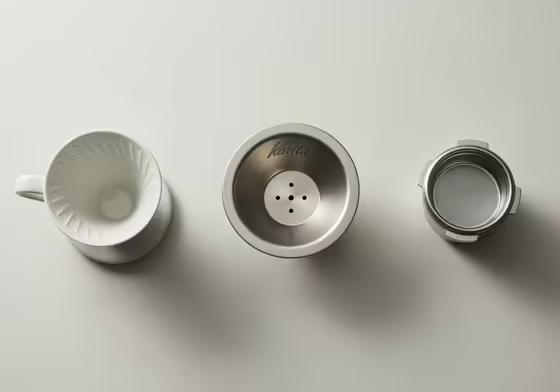
We'll look at baskets for two main types of coffee: drip coffee and espresso . For drip coffee, the basket's shape matters most. For espresso, the basket's tiny holes are the most important part.
What a Coffee Basket Does
The Jobs of a Coffee Basket
A coffee filter basket does more than just hold the grounds. It has four main jobs in the brewing process.
- Container: Its main job is to hold the coffee grounds in a neat pile for the water to pass through.
- Filtration: It separates the coffee you drink from the used grounds. This helps make the flavor clear.
- Flow Control: The basket's design controls how fast water flows through the coffee. This prevents the coffee from tasting bitter ( over-extracted ) or sour ( under-extracted ).
- Water Distribution: A good basket helps spread water evenly over all the coffee grounds. This stops water from digging a single tunnel through the coffee, which is called channeling .
The basket also plays a role in temperature. A heavy metal espresso basket can cool down the hot water if it isn't preheated. This can lead to a weak, sour shot.
But the lightweight plastic baskets in some drip brewers are actually a good thing. Plastic doesn't absorb much heat from the water. This helps the coffee brew at the right temperature from start to finish.
How Baskets Work for Drip vs. Espresso
The way a basket works is very different depending on the type of coffee you’re making.
- For Drip and Pour-Over: The basket holds a paper filter. In these gravity-fed systems, the basket's shape (like a cone or a flat-bottom) is what matters. The shape changes how long the water and coffee are in contact.
- For Espresso: The basket is a metal cup with tiny holes that holds a tightly packed puck of fine coffee grounds. The espresso machine forces hot water through the puck at very high pressure. The basket's holes are the only way for the coffee to get out.
In drip coffee, the flow is slowed down by the paper filter and the coffee grounds. In espresso, the tightly packed coffee puck creates most of the resistance needed to build pressure. Some beginner espresso baskets have a special design with just one tiny exit hole to create pressure automatically.
Does the Basket Really Matter?
Yes, the basket makes a huge difference. For drip coffee, researchers found the basket's shape ( cone vs. flat ) had a bigger impact on taste than even the coffee grind size.
For espresso, the difference is just as big. Upgrading from a standard basket to a "precision" basket gives you much more consistent results . This simple change can make your espresso sweeter and more complex.
A cheap or poorly made basket limits how good your coffee can be. No matter how great your coffee beans or grinder are, a bad basket will lead to an uneven extraction. You might upgrade your other gear and not taste any improvement until you get a better basket.
Different Baskets and How They Taste
Cone vs. Flat-Bottom Baskets
For drip and pour-over coffee, the two most common shapes are the cone and the flat-bottom basket.
- Cone Filter: These are V-shaped and guide water to flow towards a single small opening. The Hario V60 is a popular example.
- Basket Filter (Flat Bottom): These are shaped like a cupcake liner with a wide, flat bottom. This creates a shallow, even bed of coffee grounds. Most automatic drip machines use this style.
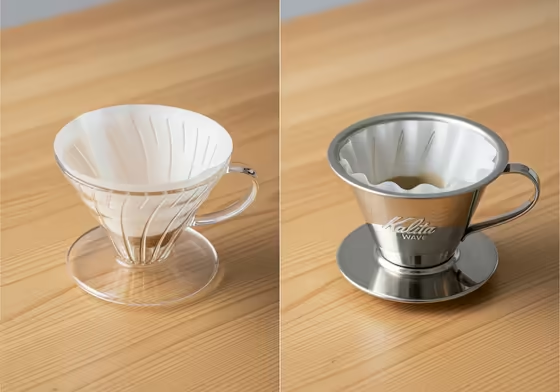
How does a basket filter work?
A flat-bottom basket creates a wide, even bed of coffee grounds. The water trickles down evenly across the whole surface. This shape slows down the water flow and gives it more time to extract flavor from the coffee.
Which is better, a cone filter or a basket filter?
Neither one is better than the other. They are just different tools that create different flavors. Choosing a basket shape is how you decide what kind of flavor you want in your cup.
Coffee experts at UC Davis did a study on this. They kept the coffee, grind, and water the same and only changed the basket shape. They found that the shape alone completely changed how the coffee tasted.
The table below shows what they found.
Table 1: How Drip Filter Baskets Change Taste
| Attribute | Cone Filter (like V60) | Flat-Bottom Filter (like Kalita) |
|---|---|---|
| Geometry | Deep, tapered pile of grounds | Wide, shallow, even pile |
| Flow Dynamics | Water flows to a center exit | Water flows evenly across the pile |
| Brew Time / Flow | Faster flow, less water contact time | Slower flow, more water contact time |
| Strength (TDS) | Higher strength (more dissolved solids) | Lower strength (less dissolved solids) |
| Resulting Body | Lighter, almost like tea | Fuller, heavier feel in your mouth |
| General Flavor | Brighter, more acidic, complex | Sweeter, more balanced, rounded |
| Light Roast Notes | Citrus, Berry, Sour | Dried Fruit, Sweet, Floral |
| Dark Roast Notes | Very Bitter, Smoky | Chocolate, Cocoa, Woody |
So, here's how you can use this. A cone-shaped basket is great for light roast coffees. It will bring out the bright citrus and berry flavors in the beans.
But if you use that same cone basket with a dark roast, it can make the coffee taste very bitter .
A flat-bottom basket is a better choice for medium or dark roasts. It brings out sweet, chocolatey, and woody flavors. It makes a balanced and comforting cup of coffee that isn't too bitter.
Espresso Baskets: Pressurized vs. Precision
For espresso, the big difference is between pressurized and non-pressurized baskets. "Precision" baskets are the best type of non-pressurized basket.
Pressurized vs. Non-Pressurized
- Non-Pressurized (Single-Wall): This is the standard basket used by professionals. It's a metal cup with hundreds of tiny holes at the bottom. To get a good shot, you have to get the coffee grind just right and tamp it down evenly.
- Pressurized (Dual-Wall): This is a beginner-friendly basket that comes with many home machines. It has an inner wall with many holes and an outer wall with only one tiny exit hole. This single hole creates the pressure for you, so it's very forgiving if your grind isn't perfect.
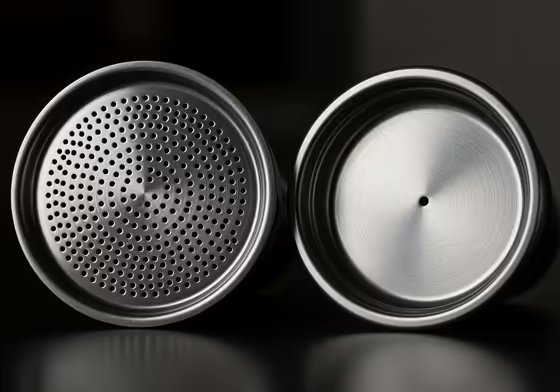
Does the portafilter basket make a difference?
Yes. Moving from a pressurized basket to a non-pressurized one is the first big step to making great espresso. The next step, from a stock non-pressurized basket to a precision one, also makes a big improvement in taste.
Does a precision basket make a difference?
Yes. The standard baskets that come with espresso machines are mass-produced and can be inconsistent. Their holes can be different sizes, and some might even be clogged. This causes water to find the easiest path through the coffee, leading to a shot that tastes both sour and bitter.
Precision baskets from brands like VST or IMS are made to fix this. They use lasers to make sure every hole is the same size and perfectly spaced. This helps the water flow evenly for a much better extraction and more consistent taste.
When you switch to a precision basket, you might notice your shots pull much faster. This isn't a bad thing. It just means the basket is more efficient and isn't clogged.
A precision basket shows you if your technique is good. To get the right shot time, you will have to grind your coffee finer. This puts the resistance back into the coffee puck itself, which is where it should be.
Why are VST baskets better?
VST baskets are known for their incredible precision. The company was started by an engineer to solve the problem of inconsistent baskets. They use lasers to measure every basket and even provide a quality report with each one.
What is the difference between IMS and VST baskets?
Both are great precision baskets, but they have slightly different goals.
- VST: These baskets are all about perfectly even holes and a fast flow. This helps you get very clear flavors, which is great for single-origin light roast coffees. They are not very forgiving if your tamping technique is off.
- IMS: These baskets are designed for a more controlled, slower flow. They are more forgiving and easier to get good results with. They tend to produce a richer, creamier espresso with more body.
- Other Differences: IMS offers some baskets with a special coating that helps the used coffee puck slide out cleanly. IMS also makes baskets for machines that VST doesn't, like the popular 54mm size for Breville machines.
How to Pick the Right Espresso Basket
Choosing the right basket is a four-step process.
- Machine Compatibility (Diameter): First, make sure the basket fits your machine. The standard is 58mm, but many home machines use other sizes like 54mm or 51mm.
- Brewing Goal (Type): If you're a beginner or use pre-ground coffee, a pressurized basket is easier. If you have a good grinder and want control, you need a non-pressurized basket.
-
Dose (Depth):
Baskets come in different sizes to hold different amounts of coffee.
- Single: 7-9 grams
- Double: 14-18 grams (this is the most common)
- Triple: 20-22+ grams (for stronger or larger shots)
- Precision (Brand): If you want the best possible espresso, upgrade to a precision basket. Choose IMS for a richer, more forgiving shot, or VST for the clearest flavor.
This table sums up the options.
Table 2: Comparing Espresso Baskets
| Attribute | Pressurized (Dual-Wall) | Non-Pressurized (Stock) | Precision (VST/IMS) |
|---|---|---|---|
| Pressure Source | The basket's single exit hole | The coffee puck (grind/tamp) | The coffee puck (grind/tamp) |
| Required Grind | Coarse / Pre-ground | Fine | Even finer than stock |
| Puck Prep Skill | Low (Beginner-friendly) | Medium (Takes practice) | High (Very important) |
| Hole Design | Two walls, one exit hole | Uneven hole sizes | Perfectly uniform holes |
| Flow Rate | Controlled by the basket | Uneven, can clog easily | Fast, efficient, even |
| Crema Quality | Foamy, not real crema | Real crema, but can be thin | Rich, thick, real crema |
| Flavor Profile | Okay, but not very complex | Good, but can be inconsistent | Sweeter, more complex, and clearer |
| Ideal User | Beginners, pre-ground coffee users | Home brewers with a good grinder | People who want the best shot possible |
How Basket Design Changes Your Coffee
How Baskets Change Water Flow
The filter basket is your main tool for controlling how fast water flows through your coffee. For drip coffee, the basket's shape sets the flow rate. A V-shaped cone makes water flow fast, while a flat-bottom basket slows it down.
For espresso, the holes at the bottom of the basket control the flow. Stock baskets have uneven holes that can clog and make the flow inconsistent. Precision baskets have perfectly uniform holes that allow water to flow through smoothly and evenly.
The shape of the basket's walls also matters. Some baskets have sloped sides, which can cause water to run down the edges too quickly. Newer baskets often have straight sides to push water down evenly through all the coffee grounds.
How Baskets Change Flavor
These differences in water flow directly change the way your coffee tastes. For drip coffee, cone baskets bring out bright, acidic flavors like citrus and berry. Flat-bottom baskets bring out sweeter, rounder flavors like dried fruit and chocolate.
For espresso, upgrading to a precision basket makes a huge difference. By getting rid of uneven flow, it produces coffee with clearer flavors. You'll taste fewer sour or bitter notes and more of the coffee's true character.
A Closer Look at Drip Baskets
The shape of the basket changes the shape of the coffee bed, which changes how water flows. A cone basket creates a tall, narrow pile of coffee. This can sometimes cause a problem called "bypass."
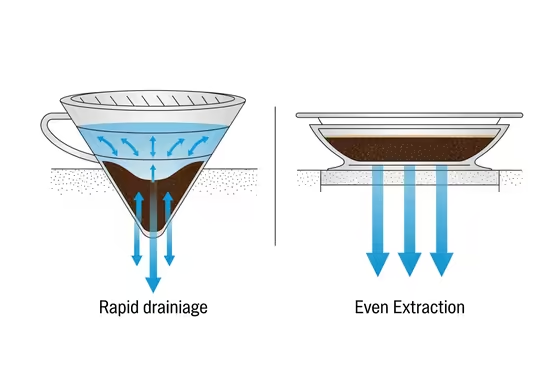
Bypass is when water runs down the sides of the paper filter instead of going through the coffee. This creates a cup that is both sour and bitter at the same time. The coffee in the middle gets over-extracted while the coffee on the sides is under-extracted.
A flat-bottom basket creates a short, wide pile of coffee. This helps the water saturate the grounds more evenly and leads to a balanced brew. It is less likely to have the bypass problem seen in cone brewers.
The Good and Bad of Paper Filters
What are the disadvantages of filter coffee?
The main downside of paper filters is about taste. Paper filters are very good at trapping tiny coffee grounds. But they also trap the coffee's natural oils.
These oils give coffee a lot of its body and rich flavor. Because the paper removes them, filtered coffee tastes very "clean" and light. Some people love this clarity, while others feel it lacks richness compared to something like a French press.
Is it better to drink coffee with or without a filter?
From a health standpoint, the answer is clear: it is healthier to drink coffee made with a paper filter . Unfiltered coffee methods like French press or espresso contain oily compounds that can raise your bad (LDL) cholesterol.
Paper filters are very good at removing these compounds. Unfiltered coffee can have 30 times more of them than filtered coffee. For this reason, doctors often recommend standard drip coffee with a paper filter as the healthiest choice.
Do you really need a coffee filter?
Yes, all coffee brewing uses some kind of filter to separate the liquid from the grounds. The real question is what the filter is made of.
- Paper Filters: Trap oils and fine grounds. This is the healthiest option and makes a clean cup.
- Metal Filters: Let oils and some fine grounds pass through. This makes a full-bodied cup but contains the cholesterol-raising compounds.
- Cloth Filters: A reusable option that traps grounds but lets some oils through. The taste is between paper and metal.
- Espresso Basket: The metal basket itself is the filter. It lets oils pass through, which is what creates the rich body and crema of espresso.
Matching Your Grind to Your Basket
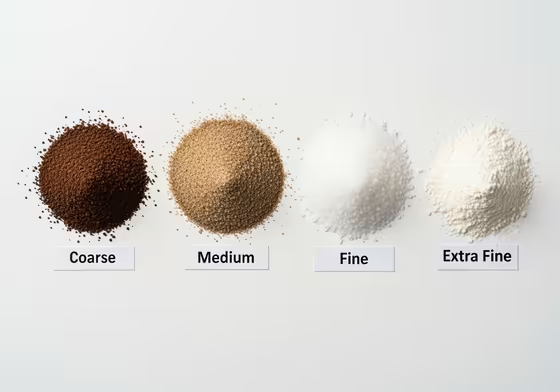
Grind Size for Flat-Bottom Baskets
For flat-bottom baskets, you should use a medium to medium-coarse grind . It should look like coarse sand.
The reason is that flat-bottom brewers have a longer brew time. A coarser grind has less surface area, which slows down extraction. This prevents the coffee from tasting bitter during the long contact time with water.
Grind Size for Cone Baskets
For cone-shaped baskets, you should use a medium-fine grind .
This is the opposite of a flat-bottom basket. Cone brewers have a shorter brew time and faster flow. A finer grind creates more surface area and resistance, which helps extract all the flavor in that short amount of time.
A Simple Guide to Grind Size
You can think of grind size as your main tool for controlling brew time. Your basket sets the starting point, and you adjust the grind to hit your target time.
-
Drip (Flat vs. Cone):
- Flat Basket (Slower Brew) → Coarser Grind
- Cone Basket (Faster Brew) → Finer Grind
-
Espresso (Pressurized vs. Non-Pressurized):
- Pressurized Basket (Creates its own resistance) → Coarse Grind
- Non-Pressurized Basket (Relies on coffee puck) → Fine Grind
-
Espresso (Stock vs. Precision):
- Stock Basket (Can clog easily) → Fine Grind
- Precision Basket (Flows very freely) → Even Finer Grind
The amount of coffee you use also affects your grind size. A single-shot espresso basket uses less coffee, creating a thinner puck. To get the right extraction time, you need to grind finer for single shots than you do for double shots.
How to Choose the Right Filter
Coffee Filter Sizes (#2 vs. #4)
People often get confused by the #2 and #4 filter sizes at the store. The only difference between them is their size and how much coffee they can hold.

Both #2 and #4 filters are for cone-shaped coffee makers. The paper quality is the same. They will make coffee that tastes identical if everything else is the same.
-
#2 Coffee Filter:
This is the smaller size.
- Capacity: Made for 2-6 cup automatic coffee makers.
- Use: Good for small 1-2 cup pour-over devices.
-
#4 Coffee Filter:
This is the larger size.
- Capacity: Made for 8-12 cup automatic coffee makers.
- Use: Fits larger 8-10 cup pour-over devices.
Using the wrong size can cause problems. A filter that's too small might collapse and dump grounds into your coffee. A filter that's too big will fold over and block the water, causing it to overflow.
Finding a Basket for Your Coffee Maker
Flat bottom filter coffee maker
Flat-bottom baskets are very common. You can find them in automatic coffee makers and manual pour-over brewers.
- Automatic Drip Coffee Makers: Most standard coffee machines, like a Mr. Coffee, use a flat-bottom basket. Even high-end brewers like the Moccamaster and Breville Precision Brewer use this shape.
- Manual Pour-Over Brewers: This shape is popular for making balanced, sweet cups of coffee. The most famous example is the Kalita Wave .
Can Coffee Filters Remove Microplastics?
A paper coffee filter by itself can't really remove microplastics from water. The plastic particles are usually too small for the filter to catch.
However, researchers found a simple trick that works. This two-step process uses a coffee filter in the final step.
Here's how it works:
- Boil Water: First, boil hard tap water for at least five minutes. Hard water has a lot of minerals in it.
- Encapsulation: When you boil hard water, the minerals form tiny solids called limescale. These little solids trap the microplastic particles.
- Filtration: After the water cools, the limescale flakes with the trapped plastic are now big enough to be caught. You can then pour the water through a coffee filter to remove them.
This method can remove up to 90% of microplastics from hard water. It doesn't work as well with soft water because it doesn't have enough minerals to form limescale.
It's important to know that this doesn't happen when you normally brew coffee. To remove microplastics, you have to do this boiling and filtering step first. Then you would use that clean water to brew your coffee.
Taking Care of Your Baskets
When to Replace Your Basket
How often you need to replace your filter or basket depends on what kind it is.
- Paper Filters: These are single-use only. You must throw them away after each brew.
- Reusable Drip Filters (Metal/Cloth): You can clean and reuse these many times. However, cloth filters can be hard to clean and can grow mold if not dried properly.
-
Espresso Portafilter Baskets:
These metal baskets
do not last forever
. The heat and high pressure wear them out over time.
- Standard Baskets (Home Use): If you make a few shots a day, you should replace the basket every 1-2 years.
- Standard Baskets (Commercial Use): In a busy coffee shop, baskets wear out fast and should be replaced every 1-6 months.
- Precision Baskets (VST/IMS): These are made from stronger steel and can last for 5 years or more with good care.
How long an espresso basket lasts depends on how well you clean it. Cleaning it properly can make it last up to 50% longer. You should rinse it every day and soak it weekly in a special cleaner to dissolve built-up coffee oils that clog the holes.